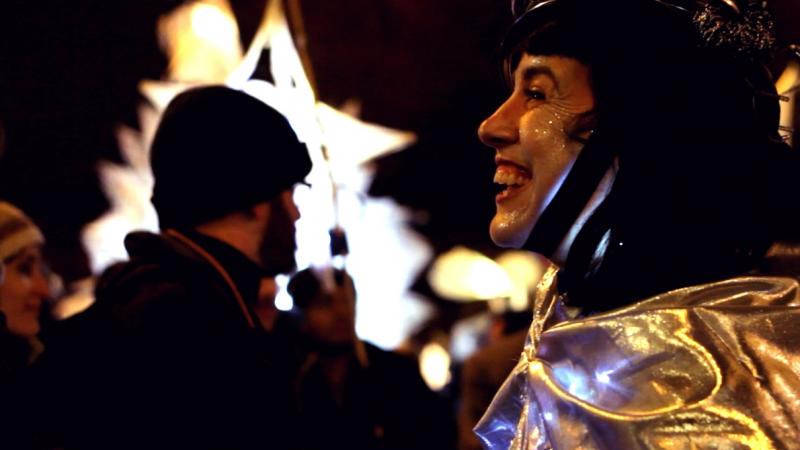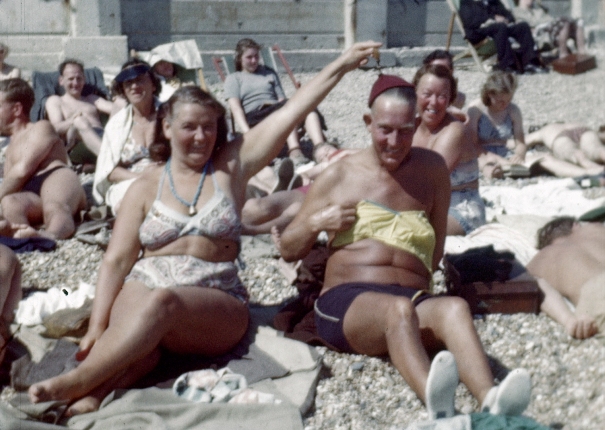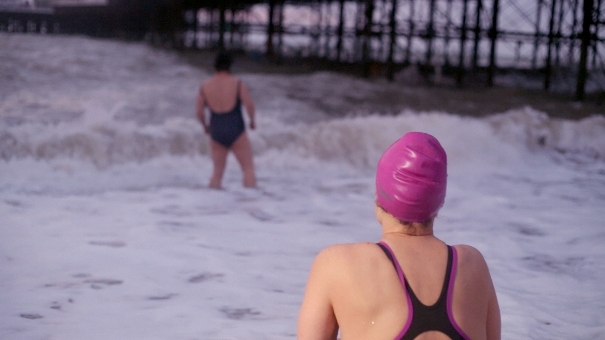Brighton Festival: Brighton – Symphony of a City, Brighton Dome | reviews, news & interviews
Brighton Festival: Brighton – Symphony of a City, Brighton Dome
Brighton Festival: Brighton – Symphony of a City, Brighton Dome
A cinematic cross-section of life in London-by-Sea

Brighton’s barely a city. It was awarded the title in 2004 without having to build a cathedral, or become bigger than a greatly swollen version of Brighthelmstone, the fishing village it once was, hemmed in from further growth by the South Downs and the sea. For all the relentless tide of London incomers and tourists, and the bustle of the bohemian North Laine, most of Brighton is quiet and peaceful, hardly urban compared to the capital.
Ed Hughes’s score in seven movements, played live by the Orchestra of Light and Sound (tonight combining professional players with Sussex students), matches Lizzie Thynne’s otherwise silent film as it moves from dawn to night. Jagged strings and percussion soundtrack fast-cut scenes of the morning rush hour around Brighton station, bakers and coffee shops. Later, strings and woodwind are more pastorally restful during the annual Gay Pride parade, a moving contrast to its riotous sonic reality which suggests the distinctiveness city status does demand: Brighton as a libertarian, sexually diverse stronghold. More than most English places, there’s licence here to do as you like.
 Thynne intercuts brief vintage footage, contrasting today’s struggling but wonderful Open Market with its Sixties ancestor. Brighton’s wide radical streak is shown in a 1938 march including banners from the local Co-op and the Communist Party of Eastbourne, their embattled hope about to be swept away: “21 Years of Peace”; “Act and It Can Be Done”; “No Unemployment in Russia”; “International Brigade – Welcome Home”. Wreath-laying for recent Spanish Civil War dead cuts to the War Memorial today, then a “Remember Gaza” banner, and flower-petals scattered by protesters in the sea. Thynne rhymes like this elsewhere, cutting from a cemetery to lively kids at a skateboard park. She also borrows from previous city symphonies with fictive moments, as when two women lock gazes in a bookshop window, and leave together.
Thynne intercuts brief vintage footage, contrasting today’s struggling but wonderful Open Market with its Sixties ancestor. Brighton’s wide radical streak is shown in a 1938 march including banners from the local Co-op and the Communist Party of Eastbourne, their embattled hope about to be swept away: “21 Years of Peace”; “Act and It Can Be Done”; “No Unemployment in Russia”; “International Brigade – Welcome Home”. Wreath-laying for recent Spanish Civil War dead cuts to the War Memorial today, then a “Remember Gaza” banner, and flower-petals scattered by protesters in the sea. Thynne rhymes like this elsewhere, cutting from a cemetery to lively kids at a skateboard park. She also borrows from previous city symphonies with fictive moments, as when two women lock gazes in a bookshop window, and leave together.
 Seeing familiar sights from a different, big-screen angle is fun for locals. The constant, poignant revelation in seeing 1927 Berlin won’t come yet, though. Maybe Southern Rail trains and grainless digital footage, dull-looking now, will gain a nostalgic strangeness with time, as the sight of people walking in a lost era usually does. The University of Sussex students filmed tapping at laptops and absorbed by screens, in between the usual youthful adventures, may date most evocatively.
Seeing familiar sights from a different, big-screen angle is fun for locals. The constant, poignant revelation in seeing 1927 Berlin won’t come yet, though. Maybe Southern Rail trains and grainless digital footage, dull-looking now, will gain a nostalgic strangeness with time, as the sight of people walking in a lost era usually does. The University of Sussex students filmed tapping at laptops and absorbed by screens, in between the usual youthful adventures, may date most evocatively.
The programme’s second half continued the silent film theme with a double-bill of Harold Lloyd’s Never Weaken (1921) and Laurel and Hardy’s Liberty (1929), with Neil Brand superbly at the piano (though Lloyd hated it as accompaniment). Lloyd’s bright irreverence and excruciatingly drawn-out sequence of attempted suicide then attempted survival, scrabbling and falling across dizzyingly high building-site girders, was urban, silent genius, crossing almost a century to fill a hall with howls of laughter.
rating
Explore topics
Share this article
Add comment
The future of Arts Journalism
You can stop theartsdesk.com closing!
We urgently need financing to survive. Our fundraising drive has thus far raised £49,000 but we need to reach £100,000 or we will be forced to close. Please contribute here: https://gofund.me/c3f6033d
And if you can forward this information to anyone who might assist, we’d be grateful.

Subscribe to theartsdesk.com
Thank you for continuing to read our work on theartsdesk.com. For unlimited access to every article in its entirety, including our archive of more than 15,000 pieces, we're asking for £5 per month or £40 per year. We feel it's a very good deal, and hope you do too.
To take a subscription now simply click here.
And if you're looking for that extra gift for a friend or family member, why not treat them to a theartsdesk.com gift subscription?
more Film
 Don't Let's Go to the Dogs Tonight review - vivid adaptation of a memoir about a Rhodesian childhood
Embeth Davidtz delivers an impressive directing debut and an exceptional child star
Don't Let's Go to the Dogs Tonight review - vivid adaptation of a memoir about a Rhodesian childhood
Embeth Davidtz delivers an impressive directing debut and an exceptional child star
 One Battle After Another review - Paul Thomas Anderson satirises America's culture wars
Leonardo DiCaprio, Teyana Taylor, and Sean Penn star in a rollercoasting political thriller
One Battle After Another review - Paul Thomas Anderson satirises America's culture wars
Leonardo DiCaprio, Teyana Taylor, and Sean Penn star in a rollercoasting political thriller
 Steve review - educator in crisis
Cillian Murphy excels as a troubled headmaster working with delinquent boys
Steve review - educator in crisis
Cillian Murphy excels as a troubled headmaster working with delinquent boys
 Can I get a Witness? review - time to die before you get old
Ann Marie Fleming directs Sandra Oh in dystopian fantasy that fails to ignite
Can I get a Witness? review - time to die before you get old
Ann Marie Fleming directs Sandra Oh in dystopian fantasy that fails to ignite
 Happyend review - the kids are never alright
In this futuristic blackboard jungle everything is a bit too manicured
Happyend review - the kids are never alright
In this futuristic blackboard jungle everything is a bit too manicured
 Robert Redford (1936-2025)
The star was more admired within the screen trade than by the critics
Robert Redford (1936-2025)
The star was more admired within the screen trade than by the critics
 Blu-ray: The Sons of Great Bear
DEFA's first 'Red Western': a revisionist take on colonial expansion
Blu-ray: The Sons of Great Bear
DEFA's first 'Red Western': a revisionist take on colonial expansion
 Spinal Tap II: The End Continues review - comedy rock band fails to revive past glories
Belated satirical sequel runs out of gas
Spinal Tap II: The End Continues review - comedy rock band fails to revive past glories
Belated satirical sequel runs out of gas
 Downton Abbey: The Grand Finale review - an attemptedly elegiac final chapter haunted by its past
Noel Coward is a welcome visitor to the insular world of the hit series
Downton Abbey: The Grand Finale review - an attemptedly elegiac final chapter haunted by its past
Noel Coward is a welcome visitor to the insular world of the hit series
 Islands review - sunshine noir serves an ace
Sam Riley is the holiday resort tennis pro in over his head
Islands review - sunshine noir serves an ace
Sam Riley is the holiday resort tennis pro in over his head

Comments
You have described it all
You have described it all well enough. But you haven't said how dull the Brighton & Hove film sequences were. Thynne hasn't got to understand Brighton at all, except perhaps as a mish-mash of its obvious cliches (beach life, pier, gay-pride, buses on Western Road, shopping, Sussex University buildings). Pathetic really. How about the very visual and exciting art, textiles and design at Brighton University; people praying at mosques, synagogues and churches; women dancing at Zumba classes or rehearsing choirs; the orchestras, the fringe and main theatres, the Albion football games and crowds; fun the parks; school life; the Royal Pavilion (for heaven's sake!); foreign students here to learn English and find freedom from parents. On top of which there is a huge weight of wonderful archive film of Brighton that this film-maker has failed to find. What a missed opportunity!
I agree absolutely with
I agree absolutely with Esther's comments; what a missed opportunity! I would add it barely touched on the wonderful range of Brighton and Hove's architecture, and as Esther's indicates, totally bizzarre not to feature the Pavilion at all !!
Couldn't agree more! What a
I think a lot more could have
I didn't think It would be
I didn't think It would be possible to make a boring film about our raffish city that 'always looks as if it's helping the police with their inquiries' (Keith Waterhouse), but I've been proved wrong. One or two good tricks, like the archive film on the mobile screen, but generally it hardly scratched the surface and, as others have said, nothing about The Albion or the Pavilion, and little about the Lanes and North Laine or of the genuinely eccentrics who live in the city ('Only in Brighton...')
I enjoyed the music but felt the piece over Pride was wrongly restrained when exuberance would have been better
Overall, an underwhelming evening
Firstly thanks very much to
Firstly thanks very much to Nick Hasted for his helpful reiew of our project. It's hard to get reviews for independent projects so this is really appreciated. Secondly a few responses to your readers who have kindly taken the time to post their thoughts. Inevitably people will have their own views about what they think is important in the city and a 45 min film will be highly selective and reflect the film-makers' partial view and intentions as well as the time of year in which the film is made (in this case the winter since the film was commisioned in Noevmebr and had to be ready by April) . (Thus not possible for instance to film language students who mainly come in summer). In order to give the film a structure and also to provide different moods and moments for the music ( which the film is primarily made to accompany) we followed the dawn to dusk structure of 'Berlin: Symphony of a City' and so what we filmed also had to give a sense of different times of day and what one might see at these times including mimicking some of the activites in our original silent film model. At the same time we wanted to introduce some historical elements integrating archive into the day-in -a life-format. There isn't acutally a lot of archive of Brighton that we could afford which isn't about the seafront and the usual places as it was mainly shot by amateurs on holiday - we drew on some of the best sections we could find of this from the wonderful Screen Archive South East who advised us as well as the amzing footage of the Communist Paty from the 1930s.
The Pavilion does actually appear but deliberately not in the kind of shot one usually sees of it. I filmed supporters at Albion but we couldn't find a way of incorporating it in the end. Permission to film at matches is very restricted as is access to schools for security/child protection reasons. Brighton isn't an especially religous city so we didn't film people worshipping but we did in fact show the 'Rise Up' choir performance in St. Barts. We also, I think, had some effective fottage of the North Laine. We wanted to produce a fiilm which presented some of Brighton's attractions although not perhaps in an expected way as well as highlighting aspects of its more everyday and festive life. We did shoot more of the city's architecture but in the end we thought that seeing the city's people was as important as seeing its buidlings. I agree some more footage of Brighton's art-making would have been nice to get but we did include shows from two key theatres - the wodnderful circus show "Flown" from the Dome and the puppet show 'Touched' from the Marlborugh. we were also interested in how people 'perform' for the camera in everyday life too though. anyway thanks again for coming to see the film!